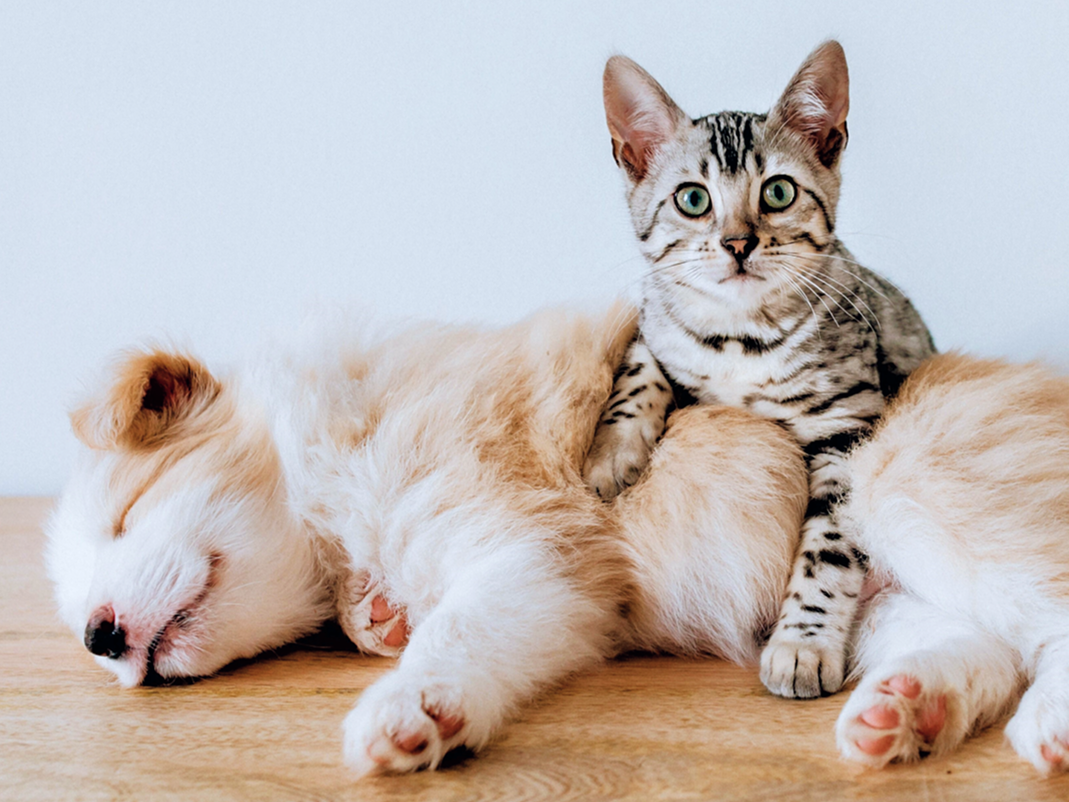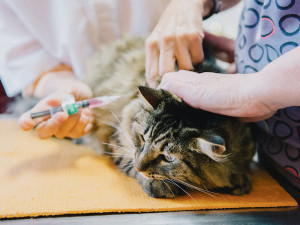Best Kitten Flea and Tick Treatments
And how to treat them.
In This Article:
Signs of Fleas in Kittens How to Treat Fleas on a Kitten Treating the Environment for Fleas Frequently Asked Questions
Fleas are no fun, and they are common in kittens. The good news is that there are many effective ways to treat them and rid your home of fleas for good. The ideal flea treatments for kittens must be specifically formulated to be safe for cats their age. Options include gentle topical solutions, carefully dosed oral medications, or other safe alternatives. Always use these treatments under the guidance of your veterinarian to ensure safety and efficacy
If you have just welcomed a floofy new kittenopens in new tab to your home and are concerned they may have fleas or ticks, it is important to seek out safe and effective treatment right away. While fleas are very common in stray kittens and all cats that spend time outdoors, they can be found on indoor cats as well. Fleas can become a nuisance if they infest your home and may even cause serious health problems in small kittens on occasion. When treating fleas, it is important to understand their lifecycle to ensure that you wipe out all life stages of the flea. Adult fleas are easy to eliminate while their egg and pupae stages are very hardy and are not easily destroyed.
Check out customizable policies from our friends at Lemonade Pet Insurance—so you only pay for what you need.
Therefore, repeat treatments are usually necessary over a number of months to completely clear a flea infestation. This includes treating all pets in the home as well as thoroughly cleaning the home environment too. It is important to always use flea and tick treatments exactly as directed on the packaging; follow instructions for the appropriate dosage and treatment schedule based on the size, weight, and age of your kitten. While there are many safe and highly effective treatment options available, if they are used inappropriately, they can cause serious health complications for some animals. Read on to learn more about treating fleas in kittens.
How much do you spend on your pet per year?
Signs of fleas in kittens
Depending on the age of your kitten and the severity of their flea infestation, signs of fleas may vary. Very young kittens who are not yet walking are not coordinated enough to scratch or bite at pesky fleas, so you may not see obvious behaviors that are consistent with fleas. For kittens that are a bit older, they may be able to react to flea bites with more classic signs. Flea bites are very itchy and cause a lot of inflammation and irritation to the skin. Common signs of fleas include:
Frequent scratching and biting at the skin
Cats with fleas tend to be very itchy and uncomfortable. They will often use their hind paws to scratch at their head, neck, and sides of their bodies. They may also bite and chew at their fur and skin to try to relieve the itch.
Flea dirt
If you part your cat’s fur all the way down to the skin, you can look for flea dirt, which looks like black dandruff or flecks of dirt on their skin. This is actually flea poop and is a common sign of fleas, even when no live fleas are visible. If you are not sure if you have found flea dirt, wet it with a damp cloth and it should turn dark red. This is because flea poop is composed of digested blood. If it turns red, you know you have flea dirt for sure.
Live fleas
This may sound obvious, but it’s not always easy to spot live fleas on a kitten. The fleas tend to be close to the skin, so if your kitten is very fluffy, all that fur provides good hiding places for the fleas. They also move fast and if you’re not watching closely, you can miss them. The best way to check for fleas is to brush out your kitten’s fur with a flea comb. These are usually metal fine-toothed combs that trap loose fur and fleas in the teeth of the comb. It also allows you to part the fur all the way down to the skin and snoop around. Even if you only see one live flea, this indicates a flea infestation; there are many more flea eggs and intermediate stages of fleas present as well.
Skin redness, rashes, scabs
All of that irritation and inflammation from flea bites and flea saliva can damage your kitten’s skin. Some kittens may have very mild reactions and only have some redness or tiny scabs on their skin. Other kittens may have a more severe reaction, known as flea allergy dermatitis, where their body launches a full blown allergic reaction to flea saliva. This can cause more extreme inflammation and redness to the skin, hair loss, scaly, and scabby patches of skin, as well as secondary skin infections. Any cat with these signs needs to see a vet right away.
Anemia
Fleas dine on the blood of their host, which is gross, and also potentially puts them at risk for anemia. This is especially true in very young, small kittens who don’t have a whole lot of extra blood to begin with. Tiny kittens with lots of fleas can actually lose enough blood from flea bites to become anemic. Kittens with anemia will have pale gums instead of healthy bubble-gum pink gums. They may also seem very tired and weak. In extreme cases, they may show signs of difficulty breathing and be unable to stand or walk. Any kitten showing any of these signs needs immediate veterinary attention.
Signs of ticks in kittens
Ticks are less common than fleas on cats, but depending on what part of the country or world you live in, they may be a concern. Ticks can be as small as poppy seeds or much larger when they are engorged with blood. Most ticks are dark in color, either brown, gray, or black, and have a round or tear-drop shape to their bodies. They have eight legs. They latch onto the skin and as they ingest their host’s blood, their bodies fill up like a tiny balloon. An engorged tick will be easier to spot and feel as a result since their body becomes larger.
Ticks do not typically cause any discomfort to their host, so your kitten will not show any signs if they have ticks. The best way to spot them is to comb through your kitten’s coat using a flea comb and to be sure to part the fur all the way down to the skin to look for smaller ticks that may not be attached or engorged yet.
How to treat fleas on a kitten
There are many safe and effective ways to treat fleas on a kitten. Many times, you’ll need to use more than one approach to completely clear a flea infestation. Be sure that the products you choose are intended specifically for cats and that they are labeled for use in a kitten of their age.
Many products will state that they are only intended to be used in kittens over eight weeks old, so if you have a very young kitten with fleas, be sure to contact a vet for the safest and most effective treatment options. Certain products containing permethrin are highly toxic to cats and are only labeled for use in dogs. Never use dog flea or tick products on cats. Some of the most effective products for kittens include:
Baths
This is a safe first step for nearly all kittens. Using a gentle cat-safe shampoo or even Dawn dish detergent can help to remove live fleas from your kitten and give them some short-term relief. Pair this with daily flea-combing to remove adult fleas and eggs from your kitten’s fur. Very young kittens have trouble regulating their body temperature, so if you do need to bathe them, be sure to safely dry and keep them warm afterwards.
Best topical flea treatment for kittens
Topical products that are effective against fleas should have ingredients that will target multiple life stages of the flea such as eggs, larva, and adults. Many of the topical products contain ingredients such as fipronil, S-methoprene, imidacloprid, and/ or selamectin. These products are usually applied monthly. It’s important not to bathe your kitten for 48 hours after application to allow these products to be properly absorbed into the skin.
Oral medications
Oral medications for fleas should clearly state if they target only adult fleas, or multiple life stages of the flea. Products that only target adult fleas can be helpful short-term to give your kitten some relief as they may kill adult fleas very quickly. These will need to be combined with another product that will also eliminate other life stages of the flea, however. If you are considering using more than one product to treat your kitten’s fleas, be sure to check with your vet that the products can be safely used together. Some of the oral products that treat fleas have ingredients such as nitenpyram, spinosad, and esafoxolaner.
Best kitten flea-and-worm treatment
Intestinal parasites are also very common in kittens as they can get them from their mother. Most kittens should be routinely dewormed to eliminate common intestinal parasites like roundworms. There are many products that target both fleas and intestinal parasites by combining medications that treat fleas with dewormers like pyrantel, praziquantel, and/or selamectin. Your veterinarian may recommend additional deworming medications if your kitten has diarrhea and/or tests positive for specific parasites.
Kitten flea-and-tick treatment
Many products combine flea and tick treatment into one package. These may contain ingredients like esafoxolaner, selamectin, sarolaner, fluralaner, and/or fipronil. Be sure to check the labeling carefully to see if they are used in the prevention and/or treatment of fleas and ticks. For the flea portion, note whether they only target adult fleas or multiple life stages.
If you are using this product as a monthly preventative, it only needs to be labeled for that purpose. However, if your cat is actively dealing with a flea infestation or has had ticks on them, you’ll want to make sure the product you select will effectively eliminate the current critters in addition to preventing future unwanted hitchhikers. This can definitely get confusing, so be sure to consult your vet if you are not sure which product is best for your current situation.
Treating tapeworms
Fleas carry an intestinal parasite called a tapeworm. When cats bite and chew at the itchy fleas on their body, they often accidentally ingest the fleas, allowing the tapeworms to set up shop. Most animals do not show any obvious signs of illness when they have tapeworms but they can affect your kitten’s growth and development if they are stealing important nutrients away from your kitten. In rare cases they may cause digestive upset including bloating, gas, abdominal pain, or diarrhea.
You may see tapeworm segments, which look like grains of white rice, around their butt as well. It’s a good idea to contact your vet to ensure your kitten and all pets in your home are treated properly for tapeworms if they have fleas. Many of the flea/tick/worm products referenced here do not kill tapeworms and only treat more routine intestinal parasites like roundworms. Your vet may need to prescribe an additional dewormer for tapeworms.
Treating the environment for fleas
Treating fleas must always include a thorough cleaning of the environment, too. This is because flea eggs and pupae can get into all parts of the home including fabrics, cracks in wood floors, and hard-to-reach places where they can remain dormant for long periods of time, waiting to reinfect your pets. Vacuum frequently to pick up any fleas that may be in the environment and be sure to dispose of the vacuum bags outside of your home right away to prevent reinfection. Wash all fabrics and dispose of any items that cannot be properly cleaned.
Clean hard surfaces regularly with appropriate cleaners that can kill fleas. Treat all pets in the home repeatedly for at least 3 months, and then start monthly preventatives on all pets to prevent reinfections. Keep up with routine vacuuming and washing of all fabrics during this time to eliminate all the life stages of the fleas as the next generation hatches. It can take a few months to completely clear the fleas out of your home so stay vigilant.
FAQs (People also ask):
What are the best flea-and-tick preventatives for kittens?
There are many effective flea-and-tick preventatives that are safe for kittens. Be sure to check the labeling on these products to confirm that they target both fleas and ticks and that they are appropriate for your kitten given their age and weight.
How to get rid of fleas on cats?
Getting rid of fleas on cats requires a multi-step approach to target the fleas on your pets, as well as other life stages of fleas throughout your home. Be sure to treat consistently for at least a few months to completely eliminate them.













